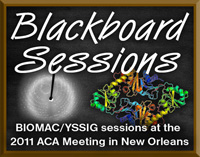Multiple Crystal Merge example
Merging together multiple 'wedges' of data or whole datasets may be necessary to obtain a dataset with the most desirable completeness or redundancy. This example is designed to simulate a case where only relatively small 'wedges' of data could be collected from crystals of a particular sample before the crystals decayed (rapidly) from radiation damage. In order to piece together a whole dataset, multiple swaths of data, collected from random orientations on multiple isomorphous crystals must be merged together to produce a complete dataset. Users will learn the considerations that go into merging multiple datasets.
These data were generated by James Holton using his MLFSOM program, which relied on the deposited structure factors to compute the spot intensities.
Useful Information
Data kindly provided by: James Holton
Sample: I1 domain from the giant muscle protein titin
PDB Code: 1G1C
Image file format: The images were created using the MLFSOM software.
Four options to download:
Option 1:Use 'rsync' (linux/UNIX command) to download all the tarred/compressed image bundles at once (command is in bewteen quotes):
and you will be prompted to enter 'lysozyme'.
- Option 2:
Use Wget to download the images (try this if you have a Windows OS).
- Option 3:
Download compressed groups of images using your web browser.
Processed Data and Instructions
| CrystalClear | Elves | HKL-2000 | iMosflm | XDS | autoPROC | PROTEUM2 | |
|---|---|---|---|---|---|---|---|
| Processed Data Files | TBA | Elves results | TBA | TBA | XDS results | TBA | TBA |
| Log Files | TBA | TBA | TBA | TBA | Links on this page | TBA | TBA |
| Author Instructions | Jim Pflugrath | James Holton | Wladek Minor | Harry Powell | Kay Diederichs | Clemens Vonrhein | Matt Benning |
| SFCheck Output | For CrystalClear file | For Elves file | For HKL-2000 file | For iMosflm file | For XDS file | For autoPROC file | For PROTEUM2 file |







